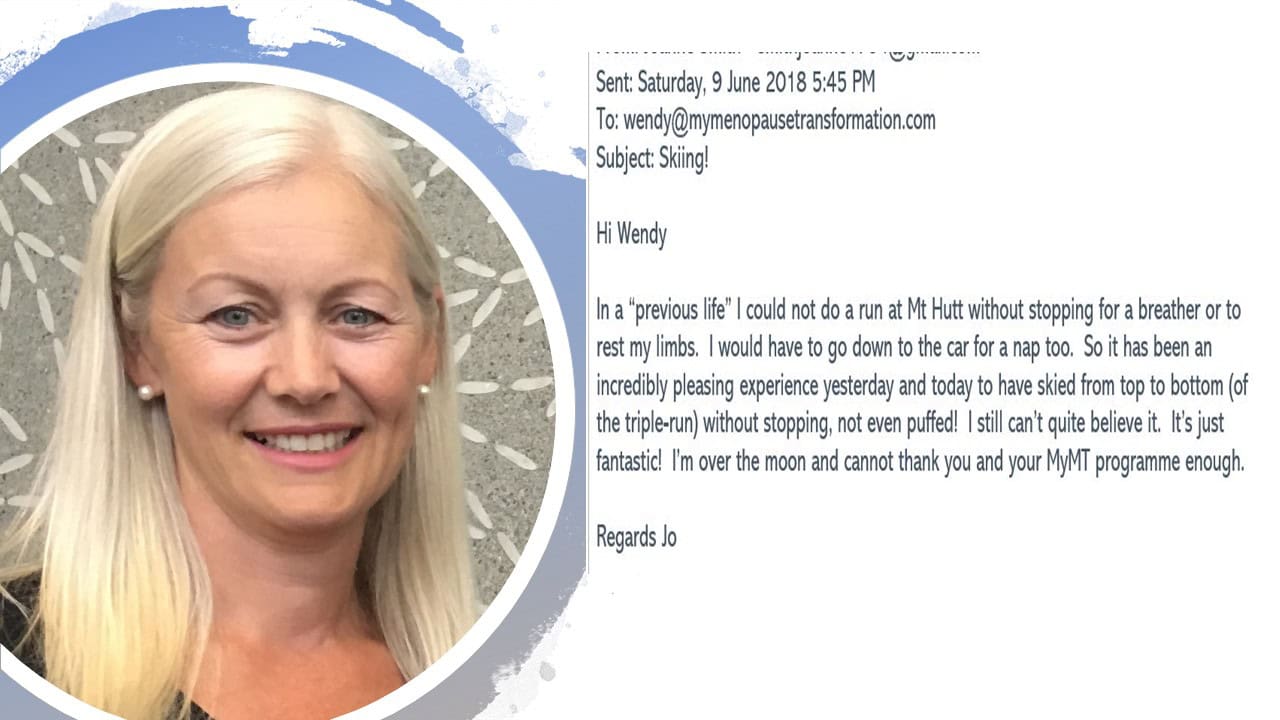I remember the fitness messages in the 1990’s. This was the time when ‘lack of time’ became the new mantra for the fitness industry. Motivated by the very new scientific domain of exercise psychology, one of the messages coming out of the emerging research, was that most people lack time to exercise. Alongside these messages, was also the very, new sports science messages, that showed if we want to improve fitness, and we don’t have much time, then we need to increase the intensity whilst decreasing the duration of the workout. Especially for weight loss. So began the 30 minute workout paradigm.
 I know this, because I was there. Managing both the personal training programme and the gym-instructors, it was the mid-1990’s that we began to set up mini 30 minute workouts for our members, at global fitness giant, Les Mills World of Fitness in Auckland, New Zealand. We knew that when lack of time became the excuse for not exercising, we needed to come up with a solution. Workouts became shorter, faster, harder. Not only did we love the endorphins, but we loved the fact that we could get through the workout faster.
I know this, because I was there. Managing both the personal training programme and the gym-instructors, it was the mid-1990’s that we began to set up mini 30 minute workouts for our members, at global fitness giant, Les Mills World of Fitness in Auckland, New Zealand. We knew that when lack of time became the excuse for not exercising, we needed to come up with a solution. Workouts became shorter, faster, harder. Not only did we love the endorphins, but we loved the fact that we could get through the workout faster.But what if these short-burst workouts don’t suit our hormonal health as we transition through menopause and we are feeling exhausted from not sleeping?
I developed this curiosity when, despite doing these types of workouts over the years, including into my late 40’s and early 50’s, my joints started to burn, my muscles ached and at night, my restless legs and muscle cramping were leaving me awake and exhausted. Apparently, I wasn’t alone. As I spoke to women on my research studies , they told me similar stories about their aching muscles, joints and restless legs. And as I’ve moved around the country doing my ‘Masterclass on Menopause’ seminars [if you missed my seminar, then there is a short version here that I’ve recorded for you], many women attending indicated these frustrations too.
That’s why I looked into what was going on.
What I learnt changed my whole approach to exercise in mid-life.
You see, as we lose oestrogen, we also lose muscle. This includes cardiac muscle.
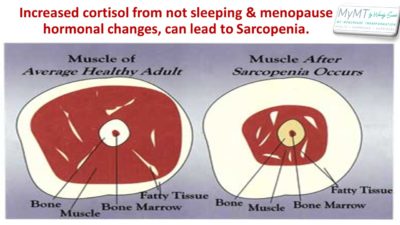
Our fibres lose both size and density and most importantly, we lose the Type 2b muscle fibres that we’ve relied on for decades to help our power and strength. Although it’s really important to do exercise which helps to reduce the loss of these fibres (fast-twitch fibres), women who aren’t sleeping all night, struggle with their recovery if they only do this high-intensity exercise. Not only do they need to re-discover how to sleep all night again, but they also need to change their exercise, until they have sorted out their sleep, hot flushes and sore joints and muscles.
That’s why I always advise women on either of the MyMT programmes that until they are sleeping well and have changed their lifestyle and their exercise to better match their menopause transition, then they need to restore their aerobic fitness and back-off all the high-intensity exercise they have been doing for years. The difference to how they feel is life-changing.
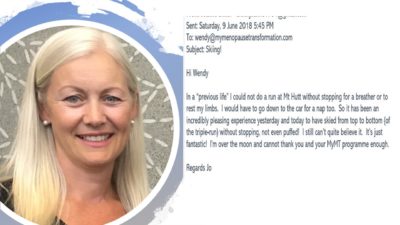
November is exercise month on MyMT and I’ve just returned from Melbourne at a wonderful women’s health and exercise conference run by Mish Wright, who is the Australian and New Zealand business manager for Curves gyms. I was so grateful for Mish asking me to present to those at the conference – women of all ages and life-stages. When I present to exercise professionals about menopause and exercise, I take off my ‘physiology-hat’ for a little while and take them on a socio-historical journey across the decades, where the intersection of exercise prescription with body-image began to rule our lives!
I show women, how, in the 1980’s, many of us were attracted to the fitness centres or community locations where Jazzercise was just getting going.
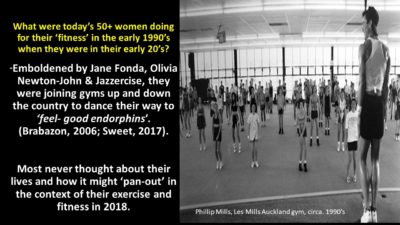 Following on from the Jane Fonda dance-based movement, we began to embrace exercise as ‘feel-good’ movement that got many women off the chores and into standing in front of the TV doing her exercise classes. Almost overnight, Jane Fonda, changed the face of exercise for women. Until then, we were engaged in sports or we just ran to school, rode our bikes and were active in our day-to-day lives. Then through this new way of women working-out, throughout America, Canada, Australia and New Zealand, the dance-based exercise classes called ‘Jazzercise’ evolved. Suddenly, the gym became the place to be. When I asked women in the audience at my presentation on Saturday, who started at the gym through Jazzercise, nearly every women who was in their mid-life years, put up her hand! I put mine up too.
Following on from the Jane Fonda dance-based movement, we began to embrace exercise as ‘feel-good’ movement that got many women off the chores and into standing in front of the TV doing her exercise classes. Almost overnight, Jane Fonda, changed the face of exercise for women. Until then, we were engaged in sports or we just ran to school, rode our bikes and were active in our day-to-day lives. Then through this new way of women working-out, throughout America, Canada, Australia and New Zealand, the dance-based exercise classes called ‘Jazzercise’ evolved. Suddenly, the gym became the place to be. When I asked women in the audience at my presentation on Saturday, who started at the gym through Jazzercise, nearly every women who was in their mid-life years, put up her hand! I put mine up too. At the same time that the physical landscape was changing for women, so too was the sporting landscape. In the 1980’s and 1990’s there was a phenomenal growth in jogging, triathlons, women’s events and more. And alongside this movement, grew the Sport and Exercise Science movement, which was fueling the increased emphasis for men and women to get fitter. Commissions were set up by governments and in New Zealand we had the Hillary Commission which was tasked with increasing the activity levels of New Zealanders in sports and physical activity. With political messages starting to teach us that we needed to do more exercise, so also evolved the Personal Training industry. I started that industry and was New Zealand’s first gym-based PT. Looking back, I was great at motivation but based on my Physical Education training, I trained all clients the same. Men and women. After all, back then, there was no difference in exercise prescription. Today, that is still the same. Hormonal differences in how we respond to exercise was not taught anywhere.
With my socio-historical hat on, as I did my doctoral studies, and because I was there growing the fitness and PT industry in New Zealand and Australia at least, I also knew that with this growth in numbers of PT’s, there was also increasing pressure to get growth in members of gyms. That’s when we all became hooked on this model of training and the 30 minute workouts. After-all, the growth in sport and exercise psychology over this time too, was teaching us that the greatest barrier to people going to the gym, or not doing exercise or being active, was LACK OF TIME.
So, imagine my surprise when preparing for my session at the recent conference, I came across a brand new 2018 report from the Australian Institute of Health and Welfare, on Physical Activity Across the Life-Stages. Here’s what it states on pg vii:
‘Not enough time’ and health issues remain a barrier for participation in physical activity and exercise. Almost 4 in 10 adults aged 18–64 (37%) reported ‘Not enough time’ or ‘Too many other commitments’ as the main barriers to participating in sport or recreational physical activities. As age increased, ‘Poor health or injury’ was more frequently cited as the main barrier—increasing from almost one-fifth (18%) of those aged 35–44 to almost half (48%) of adults aged 65 and over.*
Not much changes does it?! And yes, we can all relate to this statement. But here’s the thing. To mitigate this barrier of ‘no time’, the fitness industry continue to promote 30 minute workouts of high intensity. Yes, this has increasing evidence as a way to improve cardio-metabolic health. This is because the ‘after-burn’ i.e. the 3-4 hours after the higher intensity exercise is when fat-burning occurs as our body returns to it’s resting metabolic state and our metabolism passes in ‘aerobic’ mode again. So, what began to be marketed was the no-pain, no-gain’ workouts. These workouts have been around for years. And those attending my seminar from Curves gyms, have the 30 minute strength workouts as their main way of programming for women. Which is a fabulous way to work out. However, for women transitioning through menopause and into post-menopause, we may be forgetting about the importance of aerobic exercise, [i.e. steady-state exercise, up to an hour], where women are working moderately and improving their cardio-vascular fitness. This type of exercise, not only helps with heart-health, but also helps to stimulate the development for new mitochondrial cells in muscles – the site of fat-burning.
When women only do 30 minute workouts of higher intensity on most days of the week, they are not getting the beautiful steady-state ‘aerobic’ activity, that is best for heart health, weight control, mental health and more. That’s why for the women on my programmes,
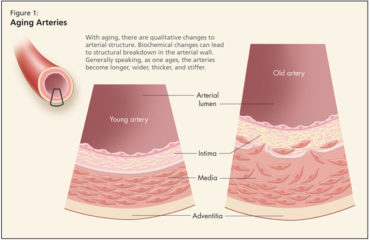 I teach them that, because our blood vessels are losing oestrogen, the blood vessels become more constricted. In ageing studies, it’s called ‘vascular stiffness’. So, when we always do high-intensity, 30 minutes workouts, then we lose-out on the ability for our muscles to remove the waste-product, lactic acid, as efficiently as they used to. But most importantly, when we only do hard-out exercise, we lose the fitness and health benefits of good old-fashioned, endurance cardio exercise. And for women’s heart health as they move into post-menopause, this is really important.
I teach them that, because our blood vessels are losing oestrogen, the blood vessels become more constricted. In ageing studies, it’s called ‘vascular stiffness’. So, when we always do high-intensity, 30 minutes workouts, then we lose-out on the ability for our muscles to remove the waste-product, lactic acid, as efficiently as they used to. But most importantly, when we only do hard-out exercise, we lose the fitness and health benefits of good old-fashioned, endurance cardio exercise. And for women’s heart health as they move into post-menopause, this is really important. When I presented this to exercise professionals in Melbourne last weekend,
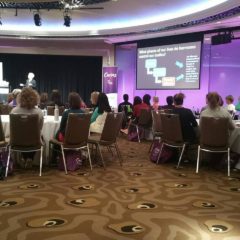
I explained why we needed to get longer duration, aerobic workouts back into our exercise prescription for middle-age and older women. There was a lot of head-nodding going on in the room. So what I asked these exercise professionals to consider was what I also get women on my ‘Re-Build My Fitness’ programme to consider too and that is –
‘Even though time is still our enemy, can you make the time, to do some longer duration, old-fashioned aerobic exercise too?’
It’s good for your health, hormones and happiness as you transition through menopause and beyond, but gets forgotten about in all the hype about high intensity exercise these days. ????
Wendy
Wendy Sweet, PhD, is the Founder of MyMT ™ – these are 12 week lifestyle-change programmes which help you to reset your hormones for menopausal weight loss and/ or symptoms reduction, using powerful lifestyle change strategies. 14 day money back guarantee.
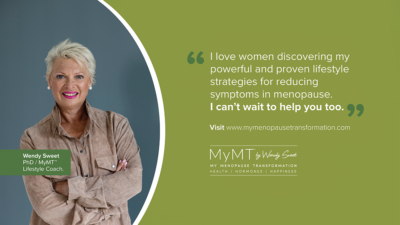 Reference:
Reference: *Australian Institute of Health and Welfare (2018). Physical activity across the life stages. Cat. no. PHE 225. Canberra: AIHW.
